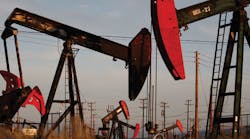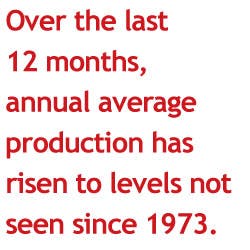Change is inevitable in business. The business cycle moves at varying speeds, but it is always flowing. Business leaders must navigate the changing winds of regulations, taxes, inflation, currency fluctuations and even Mother Nature.
A change that is always welcome is improvement in the U.S. economy. U.S. industrial production, our benchmark for the general economy, increased 3.1% over the last 12 months. In spite of a harsh winter, growth in the first three months of 2014 rose 3.7% over the year earlier. All three segments of industrial production (mining, manufacturing, and utilities) are in positive territory. Additional rise is probable through the near term, based on our rate-of-change analysis and the leading indicators.
The leading indicators cover a broad cross section of the U.S. economy, and they are showing no sign of a recession ahead. Wholesale trade is at a record high, as is retail sales. The labor market is gaining strength, nonresidential construction is recovering, and the cost of borrowing is low by historical standards. This is an attractive time for businesses to invest in efficiency-improving software and equipment.
There are headwinds that we anticipate will impact the economy and lead to a slower rate of growth by late 2014 and early 2015. More expensive health care, higher costs for housing (both on the purchase and rental side), and rising food and gasoline prices will have an impact on discretionary spending and contribute to a slowdown in housing starts and softness in retail sales. We don't see these events as breaking the back of the consumer, but merely cause a milder rate of rise in spending over the next 12 months.
Oil and gas production is booming in the United States. Over the last 12 months, annual average production has risen to levels not seen since 1973. It has been a long time coming, as the industry has seen decades of decline. Higher oil prices and advancements in hydraulic fracking technology in 2006 have led to the current U.S. development boom. Our expectation is for additional industry growth through 2015, but at a slower pace than we are currently seeing. Oil prices should weaken in the months to come due to the slower pace of economic activity globally, and this will slow down activity in oil field development.
Although the benefits of increasing energy independence are widespread, the actual oil drilled in the U.S. is quite concentrated. Over 80% of the oil produced in the U.S. comes from five states and the Gulf of Mexico. Texas is the largest oil producer, accounting for 35% of U.S. production in 2013. The Gulf of Mexico still produces 17% of our oil. The Bakken Shale region of North Dakota now accounts for 12% of U.S. production, followed by California (7%), Alaska (7%) and Oklahoma (4%).
There are a multitude of opportunities that are flowing downstream from this growth sector: everything from refineries and transportation to maintenance and commercial equipment to warehousing and chemical construction to ordinary supplies and professional services. Be prepared to take advantage of the growth opportunities -- especially once the U.S. economy gets past the slow patch in 2015. Innovation of existing products and improved services will be the key to retaining customers and increasing market share through the next 12 months. Add top-notch salespeople to help penetrate new markets. Have sufficient cash (line of credit), as new hires, wages and health-care costs squeeze cash flow over the coming two years.
Change is coming. And a lot of it is very good news.
Contributing Editor Alan Beaulieu is an economist and president of ITR (itreconomics.com). He is co-author, with his brother Brian, of "Make Your Move," a book on spotting business-cycle trends.




